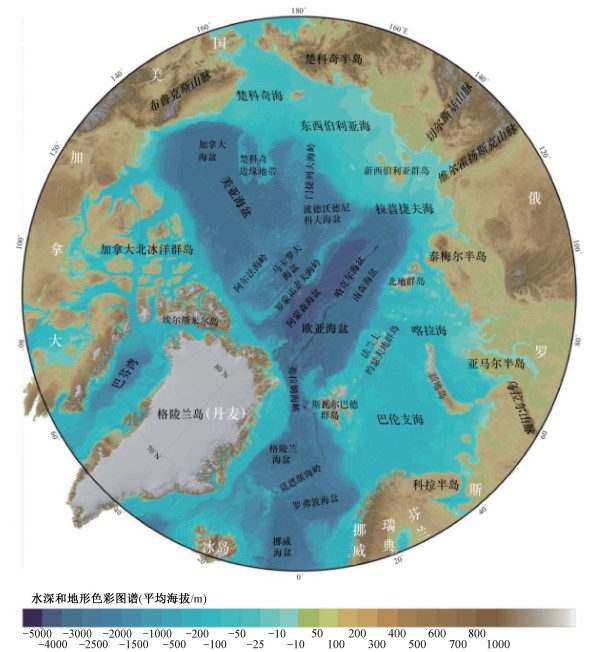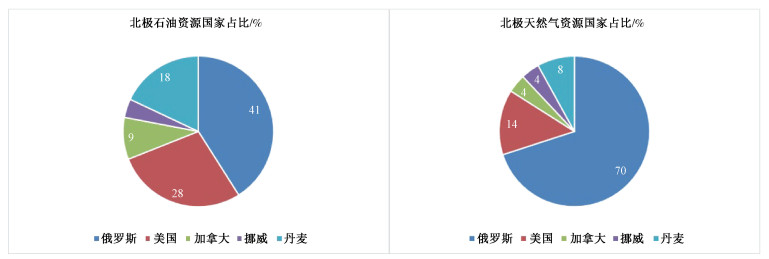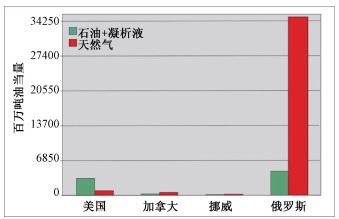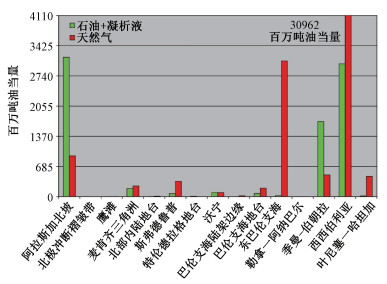Polar Silk Road and Arctic petroleum and gas resources
-
摘要:
油气是重要的战略资源。其中天然气作为清洁能源,它曾经是,现在是,在可预期的未来——全球碳减排、中国碳达峰情景下,仍然是最重要的能源资源。能源进口渠道的多元化一直是中国缓解能源紧张的有效措施之一。北极地区油气资源丰富且以天然气为主,已发现的油气资源中绝大多数在俄罗斯,尤其是天然气。但是俄罗斯天然气生产的油气田80%以上已经进入北极圈。2012年,中俄合作开发北极亚马尔液化天然气项目正式启动,标志着中国参与北极油气资源开发利用取得重要进展,也事实上开启了中国主导的"丝绸之路经济带建设"和俄罗斯主导的"欧亚经济联盟建设"对接合作的进程。北极地区已发现的油气资源共计3289.4亿桶油当量,其中石油605.4亿桶(84.1亿吨)油当量,仅为全球已发现石油资源的2.5%;天然气41.4万亿立方米(约合2683亿桶,372.6亿吨油当量),占全球已发现天然气资源的15.5%。北极地区已发现的油气总资源中绝大多数在俄罗斯,俄罗斯已发现的北极油气资源合计2905亿桶油当量(403.5亿吨),占88.3%;其中天然气约39.47万亿立方米,约合2557.9亿桶(355.3亿吨)油当量,占北极地区已发现天然气总资源的95%以上。北极待发现的油气资源量也非常可观,约占世界待发现常规石油资源的15%;天然气占世界待发现常规天然气资源的30%,其分布也主要在俄罗斯。随着全球气候变暖和能源战略博弈,俄罗斯为确保其天然气出口及财政来源,必然要加大北极油气、特别是天然气的开采和开发,并通过北极航道运到中国和其他消费国。本文在概括分析北极油气资源分布特点、俄罗斯油气资源与北极战略及北方海航道通行能力的基础上,回顾了北极亚马尔液化天然气项目诞生、发展演变及其国际博弈的背景;概括介绍了中国成功介入北极油气资源项目这一标志性事件过程,并进一步提出了中国对北极油气资源利用战略举措的建议。
Abstract:Petroleum and gas are important strategic resources, among which natural gas as a clean energy resource has always been and still will be the most important energy resource in the foreseeable future, even after cutting global carbon emissions and China peaking carbon emissions. Diversification of energy import channels has been one of the effective measures to alleviate the energy shortage in China. The Arctic region is rich in oil and gas resources and is dominated by natural gas. The vast majority of oil and gas resources found in the Arctic are in Russia, but now more than 80 percent of the Russian natural gas production is already in their oil and gas fields in north Arctic Circle. In 2012, China and Russia officially launched a joint project to develop liquefied natural gas, marking significant progress in China's participation in the development and utilzation of Arctic oil and gas resources, and in fact started the cooperative process to integrate the China-led "Construction of the Silk Road Economic Belt"and the later Russia-led "Construction of Eurasian Economic Union".The total amount of oil and gas resources discovered in the Arctic region is 328.94 billion barrels of oil equivalent, of which oil equivalent amounts to 60.54 billion barrels (8.41 billion tons), only accounting for 2.5% of the world's discovered oil resources; Natural gas amounts to 41.4 trillion cubic meters (268.3 billion barrels, 37.26 billion tons of oil equivalent), and accounts for 15.5 percent of the world's discovered natural gas resources. The vast majority of oil and gas resources discovered in the Arctic region are in Russia, which has a total of 290.5 billion barrels of oil equivalent (40.35 billion tons), accounting for 88.3%, of which natural gas amounts to about 39.47 trillion cubic meters, about 255.79 billion barrels (35.53 billion tons) of oil equivalent, constituting more than 95% of the total discovered natural gas resources in the Arctic. The Arctic also has considerable undiscovered oil and gas resources, accounting for about 15% of the world's total undiscovered amount; The undiscovered natural gas, which mainly distributes in Russia, accounts for 30% of the world's total undiscovered amount. In the context of global warming and crackdown by the US-led Western world, Russia is bound to increase extraction and development of Arctic oil and gas, especially natural gas, and transport them through the Arctic Shipping Lanes to China and other consumer countries, in order to secure its natural gas export revenue and fiscal revenue. This paper takes as the basis the summary of the distribution characteristics of oil and gas resources in the Arctic, oil and gas resources and the Arctic strategy of Russia, and the traffic capacity of the Northern Sea Route (NSR), and reviews the launch and development of the liquefied natural gas joint project as well as the international power politics environment. Moreover, this paper briefly introduces the process of China's successful intervention in the Arctic oil and gas resources project, and puts forward the strategic measures for China to utilize Arctic oil and gas resources.
-
Key words:
- Arctic /
- conventional natural gas /
- petroleum /
- Northeast Passage /
- Russia /
- Yamal Peninsula
-

-
图 1 北极地区洋底和陆域地形地貌图(据Pease et al., 2014修改)
Figure 1.
图 3 北极地区国家已发现和待发现的油气资源分布(Chew and Arbouille, 2011)
Figure 3.
图 4 北极地区油气盆地分布图(Chew and Arbouille, 2011)
Figure 4.
图 5 北极地区盆地已发现和很可能发现的油气资源分布(Chew and Arbouille, 2011)
Figure 5.
图 6 俄罗斯2008—2020年石油-天然气出口收入和财政收入油气占比(数据来自:俄联邦统计局https://rosstat.gov.ru)
Figure 6.
表 1 北极各油气盆地已发现的天然气资源(×10亿桶油当量)
Table 1. Discovered liquids and natural gas, by reservoir age (Chew and Arbouille, 2011)
液/气 美国 加拿大 挪威 俄罗斯 总计 新生界 液体 0.66 1.03 0 0 1.69 天然气 0.02 0.8 0.01 0 0.83 白垩系 液体 6 0.09 0.07 20.96 27.12 天然气 4.61 0.51 0.56 227.06 232.74 侏罗系 液体 0.76 0.46 1.04 1.36 3.62 天然气 0.11 2.07 1.23 24.61 28.02 三叠系 液体 14.62 0.04 0.11 0.74 15.51 天然气 1.8 0.21 0.4 0.5 2.91 上古生界 液体 0.89 0.03 0.01 10.84 11.76 天然气 0.17 0.02 0 3.54 3.72 下古生界 液体 0 0.03 0 0.81 0.84 天然气 0 0.08 0 0.09 0.17 总计 液体 22.93 1.67 1.22 34.71 60.54 天然气 6.72 3.69 2.2 255.79 268.4 表 2 北极及周边地区沉积盆地基本特征统计表
Table 2. Basic characteristics of the sedimentary basins in the Arctic and its surrounding areas
编号 盆地名称 国家(地区) 面积/km2 厚度/m 沉积盖层年代 基底年代 主要岩性 平均 最大 1 库克湾 阿拉斯加 44800 4600 7600 J、K2、T Pre-J 碎屑岩 2 布里斯托-圣乔治 阿拉斯加 166800 2900 5000 T-Q Pre-K 碎屑岩 3 纳瓦林 阿拉斯加 109800 3400 5300 T-Q Pre-K 碎屑岩 4 阿纳德尔 俄罗斯 75100 3000 6700 K2、T Pre-K 碎屑岩 5 诺顿 阿拉斯加 98400 1500 6500 T Pre-K 碎屑岩 6 霍普-南楚科奇 阿拉斯加 218900 2000 3000 K2、T Pre-K 碎屑岩 7 维尔基茨-北楚科奇 阿拉斯加、俄罗斯 385500 2300 6000 J-K、T Pre-M 碎屑岩 8 考尔维尔 阿拉斯加 291200 4900 9100 Pz2-T Pre- 
碎屑岩和碳酸盐岩 9 阿拉斯加-波弗特陆架 阿拉斯加 134600 3000 9100 K2、T Pz1 碎屑岩 10 马更些三角洲-波弗特海 加拿大 388500 2300 6000 J-K、T Pre-M 碎屑岩、碳酸盐岩 11 加拿大北极大陆 加拿大 489500 1500 4900 -Kz2、K2 Pre- 
碳酸盐岩、碎屑岩和蒸发岩 12 伊戈尔平原 加拿大 26200 5800 7000 Pz、J-K Pre- 
碳酸盐岩、碎屑岩 13 坎迪克 加拿大、阿拉斯加 20800 3000 5500 Pz、J-K Pre- 
碎屑岩和碳酸盐岩 14 北极群岛陆架 加拿大 388500 3000 6100 K、T、Q Pre-K 碎屑岩 15 斯维尔德鲁普 加拿大 313100 4700 10700 Pz1、Mz、T Pz1 碳酸盐岩、碎屑岩和少量蒸发岩 16 富兰克林-格陵兰 加拿大、格陵兰 349600 4600 9100 Pz1 Pre- 
碳酸盐岩、碎屑岩和少量蒸发岩 17 北极群岛古陆块 加拿大 782400 1600 4600 Pz1 Pre- 
碳酸盐岩、碎屑岩和少量蒸发岩 18 哈得逊湾 加拿大 971200 700 2400 Pz1、K Pre- 
碳酸盐岩、少量碎屑岩 19 福克斯 加拿大 168300 300 600 Pz1 Pre- 
碳酸盐岩、少量碎屑岩 20 拉布拉多陆架 加拿大 396300 4900 9100 Pz2、Mz、T Pre-  、Pz1
、Pz1碎屑岩、少量碳酸盐岩 21 西南格陵兰 格陵兰 230500 2600 7000 Pz2、Mz、T Pre-  、Pz1
、Pz1碎屑岩 22 巴芬湾 加拿大、格陵兰 569800 2700 6100 Pz2、Mz、T Pre-  、Pz1
、Pz1碎屑岩 23 东格陵兰 格陵兰 297900 2700 9000 Pz2、Mz、T Pre-  、Pz1
、Pz1碎屑岩、碳酸盐岩 24 林肯海 格陵兰 85500 3000 7000 Pz2、Mz、T Pz1 碎屑岩、碳酸盐岩 25 汪达尔海 格陵兰 41400 2000 4600 Pz2、Mz、T Pz1 碎屑岩、碳酸盐岩 26 中挪威 格陵兰 157800 3300 8200 Tr、J、K Pre-T 碎屑岩、碳酸盐岩 27 西巴伦支海 挪威 466800 2700 4600 Pz2、Mz、T Pz1 碎屑岩、碳酸盐岩 28 东巴伦支海 俄罗斯 384500 10000 11000 Pz2、Mz、T Pz1 碎屑岩、碳酸盐岩 29 蒂曼-伯朝拉 俄罗斯 443700 7000 10000 Pz、Mz Pre- 
碎屑岩、碳酸盐岩 30 西西伯利亚 俄罗斯 1932100 9000 16000 Mz、T Pre- 
碎屑岩、少量碳酸盐岩 31 北喀拉海 俄罗斯 349900 6700 7000 Pz2-T Pre-  、Pz1
、Pz1碎屑岩、少量碳酸盐岩 32 通古斯 俄罗斯 699500 3700 7500 PR2、Pz、T-J Pre- 
碎屑岩、碳酸盐岩 33 阿纳巴尔-哈坦加 俄罗斯 390600 4600 9000 Pz、Mz、T Pre-  、Pz1
、Pz1碎屑岩、碳酸盐岩 34 维柳伊 俄罗斯 313000 3000 11000 Pz2、T、J Pre- 
碎屑岩、碳酸盐岩 35 拉普捷夫海 俄罗斯 326500 3700 7000 Pz、J-K Pz1 碎屑岩 36 济良卡 俄罗斯 115000 2100 4000 Pz、Mz、T Pre- 
碎屑岩 37 东西伯利亚海 俄罗斯 136800 3000 5800 Pz、P-Tr、J-K、T Pre-  、Pz1
、Pz1碎屑岩 表 3 2013年以来北极东北航道通过船舶情况/艘(俄罗斯北方海航道管理局www.NSRA.ru)
Table 3. Vessels through the Northeast Passage since 2013(Data from the Northern Sea Route Administration, www.NSRA.ru)
2013年 2014年 2015年 2016年 2017年 2018年 2019年 2020年 合计 船舶总数 635 631 715 718 662 792 799 1002 5954 俄罗斯 509 520 590 574 555 701 699 846 4994 外国籍(不包括中国) 126 111 125 144 107 91 100 156 960 中国(中远海特运公司) 1 0 2 6 5 8 9 11 42 -
Arctis Knowledge Hub, 2014. History of arctic marine transport[EB/OL]. [2021-05-11]. http://www.arctis-search.com/History+of+Arctic+Maritime+Transport&structure=Transportation+Research.
BP, 1951, 2008, 2009, 2010, 2011, 2012, 2013, 2014, 2015, 2016, 2017, 2018, 2019, 2020. Statistical review of world energy[EB/OL]. [2021-05-11]. https://www.bp.com/en/global/corporate/energy-economics/statistical-review-of-world-energy.html.
CCTV News Channel, 2017. [EB/OL]. [2021-04-20]. https://tv.cctv.com/live/cctv13. (in Chinese)
CHEW K J, ARBOUILLE D, 2011. Hydrocarbon finds in the Arctic basins: discovery history, discovered resources and petroleum systems[J]. Geological Society, London, Memoirs, 35(1): 131-144. http://www.onacademic.com/detail/journal_1000038122166110_0d2c.html
EIA(Energy Information Administration), 2008, 2011, 2012, 2013, 2015, 2016, 2017. EIA estimates based on International trade data, Eurostat and Russian export statistics and partner country import statistics, Global Trade Tracker (subscription)[Z].
European Commission, 2011. Communication from the commission to the European Parliament, the council, the European economic and social committee and the committee of the regions[R]. Energy Roadmap 2050, COM(2011)885/2: 1-20.
Gao T M, 2019. How does Russia view the "Silk Road on Ice"?: Zhihu. [2021-05-11]. https://zhuanlan.zhihu.com/p/60569122. (in Chinese)
JIN Z J, 2019. "Scientific and technological innovation determines the trend of energy industry in the future". "2019 influence summit-foreseeing the future" co sponsored by China Daily and NeteaseNews[EB/OL]. [2021-05-11]. http://cn.chinadaily.com.cn/a/201901/05/WS5c3081b9a3100a343d6f2228.html?ivk_sa=1023197a. (in Chinese)
LINDHOLT L, GLOMSRØDS, 2012. The Arctic: no big bonanza for the global petroleum industry[J]. Energy Economics, 34(5): 1465-1474. http://www.onacademic.com/detail/journal_1000036093180310_c96d.html
LIU J M, ZHAO Y, YIN J Y, et al., 2017. Arctic geology and oil and gas resources[M]. Beijing: Geological Publishing House: 1-336. (in Chinese)
Northern Sea Route Information Office, Transits, 2011, 2012, 2013, 2014, 2015[EB/OL]. [2021-03-15]. https://arctic-lio.com/category/data_reports.
Observer Network, 2017. Super project: China-Russia Arctic natural gas project put into operation, Putin ship in person[EB/OL]. [2021-03-15]. https://www.guancha.cn/global-news/2017_12_09_438476_s.shtml. (in Chinese)
PEASE V, DRACHEVS, STEPHENSON R, et al., 2014. Arctic lithosphere: a review[J]. Tectonophysics, 628: 1-25. http://www.sciencedirect.com/science/article/pii/S0040195114003060
Russia 《Interfax》, 2009. Russia's energy development strategy 2030[EB/OL]. [2021-05-11]. http://www.interfax.ru. (in Chinese)
USGS, 2008. Circum-arctic resource appraisal: estimates of undiscovered oil and gas north of the Arctic circle[R]. USGS Fact Sheet 2008-3049.
VOSER P, 2012. The natural gas revolution: a secure, abundant force for good[C]//Proceedings of the 31st annual CERAWeek executive conference. Houston, Texas, USA: 3-4.
WANG H Y, 2020. Sino-Russian cooperation in arctic oil and gas (internal report)[R]. Beijing: Institute of Geomechanics, Chinese Academy of Geological Sciences. (in Chinese)
ZHAO Y, 2013. Russia's Arctic oil and gas development in the new situation[R]. Internal report of Research Institute of Petroleum Exploration and Development. Beijing: Institute of Geomechanics, Chinese Academy of Geological Sciences. (in Chinese)
ZHU W L, WANG Z X, WU P K, et al., 2013. Petroliferous basins around the Arctic[M]. Beijing: Science Press: 1-312. (in Chinese)
高天明, 2019. 俄罗斯如何看待"冰上丝绸之路"?: 一带一路大家谈, 知乎[EB/OL]. [2021-05-11]. https://zhuanlan.zhihu.com/p/60569122.
俄罗斯《国际文传电讯社》, 2009. 俄罗斯能源发展战略2030[EB/OL]. [2021-05-11]. http://www.interfax.ru.
观察者网, 2017. 超级工程: 中俄北极天然气项目投产普京亲自装船[EB/OL]. [2021-03-15]. https://www.guancha.cn/global-news/2017_12_09_438476.shtml.
金之钧, 2019. 能源行业发展, 技术进步是关键[EB/OL]. [2021-05-11]. http://cn.chinadaily.com.cn/a/2019-01-05.
刘建民, 赵越, 殷进银, 等, 2017. 北极地质与油气资源[M]. 北京: 地质出版社: 1-336.
王海燕, 2020. 中俄北极油气领域合作[R]. 北京: 中国地质科学院地质力学研究所.
央视网新闻频道, 2017. 习近平同俄罗斯总统普京举行会谈[Z/OL]. [2021-04-20]. https://tv.cctv.com/live/cctv13.
赵越, 2013. 新形势下俄罗斯北极油气的开发[R]. 北京: 中国石油勘探开发研究院.
朱伟林, 王志欣, 吴培康, 等, 2013. 环北极地区含油气盆地[M]. 北京: 科学出版社: 1-312.
-




 下载:
下载:




